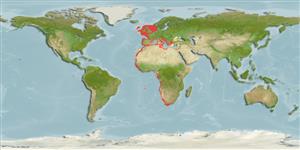Common names from other countries
Classification / Names / Names
ماع يماسا | فدارتم | Catalog of Fishes (gen., sp.) | ITIS | CoL | WoRMS
Environment: milieu / climate zone / depth range / distribution range
يسانش موب
.دننک یم هیذغت و یگدنز ،زاورپ تیلباق اب اه هنوگ یخرب رد و بآ حطس ات یبآ نایم یاه تمسق رد ،رتسب فک یور ای و رتسب کیدزن زا دازآ یاهبآ زا یعیسو هدودحم رد هک یتادوجوم; قمع تارييغت 0 - 500 m (Ref. 275), usually 20 - 250 m (Ref. 275). Temperate; 13°C - 20°C (Ref. 2453), preferred 18°C (Ref. 107945); 60°N - 36°S, 19°W - 37°E
Eastern Atlantic and the Mediterranean: from North Sea and British Isles to southwest Africa and the Mediterranean.
Length at first maturity / Size / Weight / نس
Maturity: Lm 16.9, range 16 - 23 cm Max length : 64.0 cm ML يسنج صاوخ نودب / رن سنج; (Ref. 417); 32 cm ML (female); هدش شرازگ نزو هنيشيب: 1.5 kg (Ref. 275)
Paralarvae: Fins paddle-shaped, broad with short bases, fin much wider than long. Mantle broad with few large dorsal chromatophores and numerous ventral chromatophores. Head squarish with few chromatophores on dorsal surface and 12 chromatophores on ventral surface arranged in 2 cheek patches of 5 posterior to eyes and a pair between the eyes. Ventral arms with 2 aboral chromatophores. Tentacles with 4 aboral chromatophores. Tentacular clubs broad and wider than tentacular stalks. Mantle length at hatching range between mantle length 0.28 and 0.358 cm (Ref. 2489, 2490).
Juveniles and adults: Mantle muscular, cylindrical, slender and elongated posteriorly. Wide spots of red chromatophores in mantle and green/blue iridescence in posterior part of mantle. Fins rhomboid with length exceeding 50% of mantle length. Buccal membrane with 15 suckers with chitinous rings on extremity. Male's left ventral arm hectocotylized with length ranging from 15 to 33% of whole arm length. Arms with 2 rows of suckers, sucker rings with 20 teeth, distal ones large and pointed and proximal ones minute or absent. Tentacles not retractile and tentacular clubs with 4 longitudinal rows of suckers in the "manus", which in central rows are larger than marginal ones. Cartilages simple locking (Ref. 275, 1964).
Maximum life span: 1.5 to 2 years in females and 3 to 3.5 years in males (Ref. 2525). Maximum size for male, 64 cm, mantle length from Ref. 2494. Neither pelagic nor fully benthic. Inhabits circumlittoral zone and upper bottoms of bathyal systems (Ref. 2504). Exhibits benthic behavior during spawning season and pelagic behavior at other times, e.g., during hunting (Ref. 2493). Carnivorous predators (Ref. 2526); juvenile feeds on planktonic prey, e.g. copepods, mysids and euphausiids (Ref. 2525) while adult frequently feeds on fish (Ref. 2526) and sometimes on cephalopods and crustaceans.
Life cycle and mating behavior
غولب | لثم دیلوت | یزیر مخت | اه مخت | Fecundity | )ورال ( دازوت
Members of the class Cephalopoda are gonochoric. Male and female adults usually die shortly after spawning and brooding, respectively. Mating behavior: Males perform various displays to attract potential females for copulation. During copulation, male grasp the female and inserts the hectocotylus into the female's mantle cavity where fertilization usually occurs. Life cycle: Embryos hatch into planktonic stage and live for some time before they grow larger and take up a benthic existence as adults.
یلصا ذخآم
عجارم | هدننك گنهامه | ناراكمه
Piatkowski, U. 2006. (Ref. 2488)
NCUI زمرق تسرهف رد تيعضو (Ref. 130435)
ستياس رظن زا تيعضو (Ref. 108899)
Not Evaluated
Not Evaluated
یناسنا هدافتسا
تاليش – يريگ يهام: يراجت
FAO - تاليش – يريگ يهام: landings | FishSource | Sea Around Us
اهرازبا
يتنرتنيا عبانم
Estimates based on models
Preferred temperature
(Ref.
115969): 7.4 - 19.4, mean 11 (based on 1556 cells).
یگدنهج
دايز, هام 51 زا رتمك ، تيعمج ندش ربارب ود يارب مزال نامز هنيمك (K=0.13-1.66; tm=0.78).
Prior r = 0.39, 95% CL = 0.26 - 0.58, Based on 2 full stock assessments.
یريذپ بيسآ
Low vulnerability (19 of 100).
